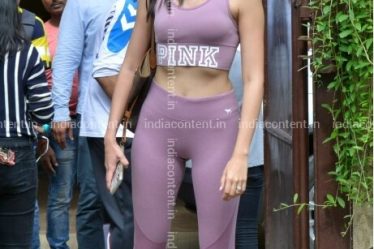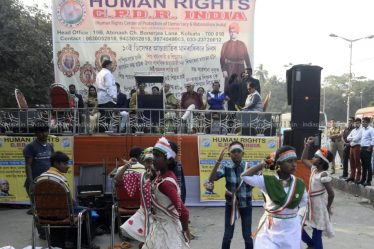
Durga Puja, a major festival of Hinduism, traditionally celebrated for 10 days in the month of Ashvina (September–October), which is the seventh month of the Hindu calendar, and majorly celebrated in Bengal, Assam, and other eastern Indian states. Durga Puja celebrates the victory of the goddess Durga over the evil demon buffalo king Mahishasura. The celebration begins till Navratri, a nine-night festival celebrating the divine power of the feminine.
Durga Puja’s first day is called Mahalaya, which marks the advent of the goddess. Celebrations and worship begin from Sashthi, which is the sixth day of Durga Puja. During the following three days, the goddess Durga is worshipped in her various forms as Durga, Lakshmi, and Sarasvati. The celebrations end with Vijaya Dashami or Dussehra(“The Tenth Day of Victory”), when, amid loud chants, hymns and drumbeats, idols of Gods and Goddesses are carried in huge processions to local rivers, where they are immersed. That custom is a symbol of departure of the deity to her home and to her husband, Lord Shiva, in the Himalayas. Images of the goddess Durga—astride a lion, attacking the demon buffalo king Mahishasura—are placed at various places (these places are elaborately decorated with bamboo structures and galleries) and temples.

Durga Puja State Wise Celebration
States in India and their unique style of Durga Puja celebrations
Navratri celebrations in different states of India are performed differently, calling on the people to reassert their faith in the Divine power Mother Durga and her manifestations. India is a diverse and multi-cultural country.
Uttar Pradesh, Bihar:
There are various similarities in the way Durga Puja is celebrated in the states of UP and other parts of Bihar, as they feed little girls (kanjak) on the final day of worship.
West Bengal, Assam
Grand pandals (setups decorated with bamboo sticks) are set up in different themes every year in West Bengal to enshrine beautiful idols of Goddess Durga, Lord Ganesha, Lord Kartikeya, Goddess Saraswati, and Mother Lakshmi. Priests perform rites as per scriptural injunctions for a period of almost four days. On Dashami (tenth day), the Goddess is bidden farewell with great pomp and show. Assam also follows a similar practice of worshipping the Goddess Durga.

Gujarat
Devotees celebrate the Navratri festival in Gujarat by observing fasts of nine days and performing the famous traditional dance Garba. The worship is concluded by feeding young girls (kanjaks), and bidding them adieu with money and various gifts.
Tamil Nadu
The Tamilians worship majorly the three Goddesses: Goddess Durga, Mother Saraswati, and Mother Lakshmi during the last three days of the Navratri. There is a longstanding tradition of inviting relatives home and giving them appropriate gifts.
Punjab
The citizens of Punjab are as much attached to Durga worship as we witness in other states. During the nine holy nights of Durga celebrations, daily jagrans (lord prayers) are held in temples. On the days of Ashtami and Navami, the devotees invite young girls (kanjaks) in the age group of 5 to 10, and honour them.
Andhra Pradesh
During the Navratra pujan, it is time for the women of Andhra Pradesh to invoke Mother Gauri, the benign goddess and a form of Goddess Durga, for blessing them with bliss. Unmarried girls join the communal worship to seek a spouse of their choice or a perfect person whom they can marry. The festival is called “Bathukamma”.
Karnataka
In Karnataka (all parts of the state), the celebrations held in the ancient city of Mysore are peerless and unmatchable. The tradition of Navratri or Nadahabba celebrations was kick-started by the reign Vijayanagara Dynasty in the 17th century to mark the victory of Durga over the evil demon buffalo.
Durga Puja Significance
According to mythology, the festival marks the victory of goddess Durga in her battle against the shape-shifting buffalo demon Mahishasura. In this way, the festival epitomises the victory of good over evil power, though it is also considered as a harvest festival celebrating the goddess as the motherly power behind all of life and creation. Durga puja coincides with Maha Navaratri and Dussehra (the tenth day of Durga Puja) celebrations observed by other traditions or rituals of Hinduism, in which the Ram lila or theatre performance, sort of dance-drama is enacted, celebrating the marvelous victory of Rama against Ravana, and effigies of Ravana are completely burnt.
Though the primary or the main goddess revered during Durga puja is Durga, but here the celebrations also include other major deities of Hinduism such as Lakshmi (the goddess of happiness, wealth, prosperity), Saraswati (the goddess of immense knowledge and music), Ganesha (the god of good beginnings and blessings), and Kartikeya (the god of war or also known as murugan). As per Bengali traditions, these deities are considered to be Durga’s children and Durga puja is believed to commemorate Durga’s visit to her natal (maternal) home with her children. The festival is started with Mahalaya which is believed to mark the start of Durga’s journey to her parental home. Main celebrations begin on the sixth day (Shasthi), in which the goddess is welcomed with rituals to her home. The devotees enjoy foods and other stuff in pandals. Aarti happens every day till the visarjan. The puja continues with great fervor on the seventh day (Saptami) and the eight-day (Ashtami) which includes Sandhi puja, Kumari puja (worshipping the living goddess) aarti and a lot more like all other days. The ninth day (Maha Navami) ends with yagna.
On the last day of Durga Puja (Vijaydashmi), Bengali women smear each other with sindur which is called ‘Sindur khela’ (vermillion game) and devotees embark on a procession carrying the worshipped mud sculpture-idols to a river, or other water bodies, and finally immerse them, symbolic of her return to the divine cosmos and to her marital home with Lord Shiva in Kailash.Regional and community variations in celebration of the festival and rituals are actually observed.

Durga puja is a very old tradition of Hinduism, though its exact origins are lttle unclear. Surviving manuscripts from the very14th century provide guidelines for Durga puja, whereas historical records suggest that the royal and wealthy families were sponsoring major Durga puja festivities since 16th-century. The prominence of Durga puja increased during the British period in the provinces of Bengal and Assam.In today’s time, the importance of Durga puja is as much as a social and cultural festival and as a religious one, wherever it is observed.
Durga Puja Wishes and Quotes
-May Goddess Durga, protects our family from the evils and illuminate our lives with the light of knowledge and truth! Happy Durga Puja to all.
-It’s time to welcome Goddess Durga and thank her for all the special gifts we received this year. Let’s together make this Durga Puja a great one to remember forever!
-Wishing colours, bliss and beauty to you and your family on this Durga Puja… Stay blessed forever!!
– May Goddess Durga bless you with lots of happiness, prosperity, happiness, wealth and great fortune. I wish your Durga Puja be full of joy and contentment.
– May Mother Durga give you the courage to fight with all the evils. Happy Durga Puja to you and your family!!
– May the divine diety empower you and your loved ones with her blessings on this Durga Puja. Wish you a very Happy and glorious Durga Puja!
– On this Durga Puja, The sound of dhol seems brings melody to your life… Happy Durga Puja 2019 to you and your loved ones!
Durga Puja Images on India Content
If you are looking for Durga Puja pics then you must check the India Content website. You will find some good images on the website. The pictures are available in three sizes—small, medium and large.



